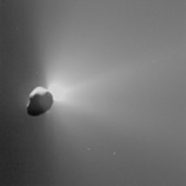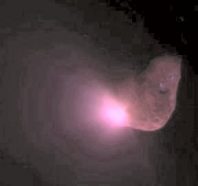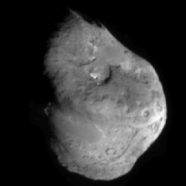An Icy Blob of Fluff
Firing a projectile into a comet has exposed an icy dirtball.
By Emily Sohn
The collision between a projectile, launched from the spacecraft Deep Impact, and Comet Tempel 1 on July 4th was pretty exciting (see “A Smashing Display“). But the excitement didn’t end there. Astronomers continue to analyze data from the event, and early findings reveal lots of new information about comets and the formation of our solar system.
 |
|
Comet Tempel 1, as seen by the Deep Impact spacecraft as it traveled away from the icy body after the collision.
|
| NASA, Deep Impact Team, University of Maryland |
Some 80 telescopes on the ground and in space monitored and recorded the crash. Scientists have been analyzing these images, most of which feature the dust that blew off the comet for 2 days after the crash.
Initial observations suggest that scientists are for the first time “directly measuring pristine material from deep inside a comet, material that has been locked away since the beginnings of the solar system,” says Deep Impact researcher Carey Lisse. He’s at the University of Maryland and the Johns Hopkins Applied Physics Laboratory.
 |
|
A haze of fine dust particles surrounds the impact site, as detected by cameras about a minute after the collision. Dredged up by a shock wave following the explosion, the dust lasted for hours and hid the crater gouged by the spacecraft’s projectile duri
|
| NASA, Deep Impact Team, University of Maryland |
Some of the results have been surprising. For one thing, scientists had long thought of comets as dirty snowballs—clumps of ice with bits of dust mixed in. Tempel 1, however, seems to be more of an icy dirtball.
The deep crater that formed after impact suggests that the comet is made up mostly of very fine dust, with some ice mixed in. Gravity holds the comet together only weakly, which makes it fragile and fluffy. The comet is so fluffy that about 80 percent its volume is empty space.
Nor does the comet consist of chunks of material squished together into one solid, as previously thought. Instead, it’s layered like an onion, say astronomers on the Deep Impact team.
 |
|
A close-up view of Comet Tempel 1 just before a copper projectile plunged into its surface.
|
| NASA, Deep Impact Team, University of Maryland |
Figuring out how comets are put together should help astronomers understand how planets are created. Comets most likely formed 4.5 billion years ago, when the rest of the solar system was also born. Yet comets have experienced less heating and melting than planets and asteroids, so they hold insights about those early days.
Cameras captured great close-up pictures of the comet, and astronomers continue to marvel at Tempel 1’s many craters, which suggest a battered life. Images also show smooth surfaces and tall cliffs that scientists can’t yet explain.
As they continue with their measurements, calculations, and observations, astronomers hope eventually to get at the heart of what comets can tell us about the history of our solar system.—E. Sohn
Going Deeper:
Cowen, Ron. 2005. Deep impact. Science News 168(Sept. 10):168-170. Available at http://www.sciencenews.org/articles/20050910/bob9.asp .
Sohn, Emily. 2005. A smashing display. Science News for Kids (Aug. 24). Available at http://www.sciencenewsforkids.org/articles/20050824/Feature1.asp .
For further information about the Deep Impact space mission, go to www.nasa.gov/mission_pages/deepimpact/main/index.html (NASA) and deepimpact.umd.edu/home/index.html (University of Maryland).







